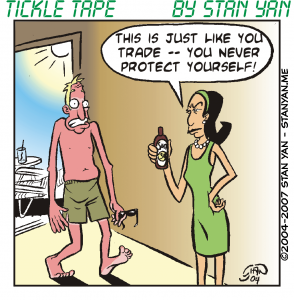Many traders view risk management as critical to long-term success. Consider what a couple seasoned traders told our Innerworth staff about risk management. Mark said, “You can have a crummy trading strategy, but if you have good money management, you can make money. If you have poor money management, it doesn’t matter how good the trading strategy is. You’re going to lose in the end.” Similarly, Chris observes, “You must have a survivability element so that if you literally wished to select stocks by throwing darts at a board, you would continue to survive market to market.”
Risk management is viewed by many as important, but what’s the best way to manage risk? Some traders use very specific rules for managing risk, such as risking a small percentage of capital on each trade. Other traders don’t seem to have any specific rules but may look at past performance as a key. (What is the volatility? What was the previous day’s low?)
As important as risk management is, not all successful traders always manage risk. Some successful traders put on big positions when they believe they see a chance to make a huge, substantial win. When they believe they are right, they just take a chance. Doing so may lead to big losses when they are wrong, but they do it when they need to.
Is taking big risks a good idea? When it comes to trading, there is no one “right” way to trade. All you can do is consider the advantages and disadvantages of each approach and decide which approach you want to take. Whether you want to take big risks may depend on your experience and trading skills. If you are a novice trader, you have not yet learned how to use a set of methods consistently to make a profit in the long term.
For novice traders, it is often vital that they control their risk (for example, risking a small percentage on each trade) so that they could survive long enough to gain mastery as a trader. One reason trading coaches preach the virtues of careful risk management is that a common mistake among novice traders is wanting to “get rich quick” and putting on big trades to make big wins.
The methods and skills of a novice trader, however, do not warrant taking such huge risks. What often happens is that they lose all of their capital on a few big trades and need to rebuild their capital before trading again. Rather than gaining mastery as a trader, they fruitlessly go through cycles of risking a lot, losing it all, quitting trading to rebuild capital, and so on. These novice traders never give themselves a realistic chance of learning how to trade consistently. In contrast, the novice traders who manage their risk can trade longer, and hopefully, learn how to trade consistently before their capital runs out.
Once a trader becomes seasoned, he or she may want to “reach the next level” and make a lot more profit. Seasoned traders often reach an asymptote, at which point a self-imposed cap limits their profits. It’s hard to break through this barrier, and no one really seems to know why. Very experienced traders who want to make greater profits need to start bending or breaking the rules a little to see if they can make greater profits and break through the barrier.
This is risky, but some seasoned traders are willing to take the risk in order to make huge yearly profits. That said, they also can afford to take more risks. As seasoned traders, they have the methods and experience to take risks, but a novice trader does not. So even though there is no right or wrong way to trade, if you are new to the trading field, risk management has the advantage of allowing you to “survive the learning curve” until you find the once-in-a-lifetime opportunities to make you wealthy beyond your wildest dreams.


